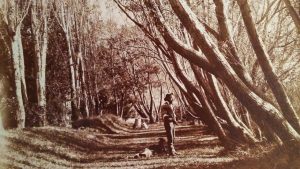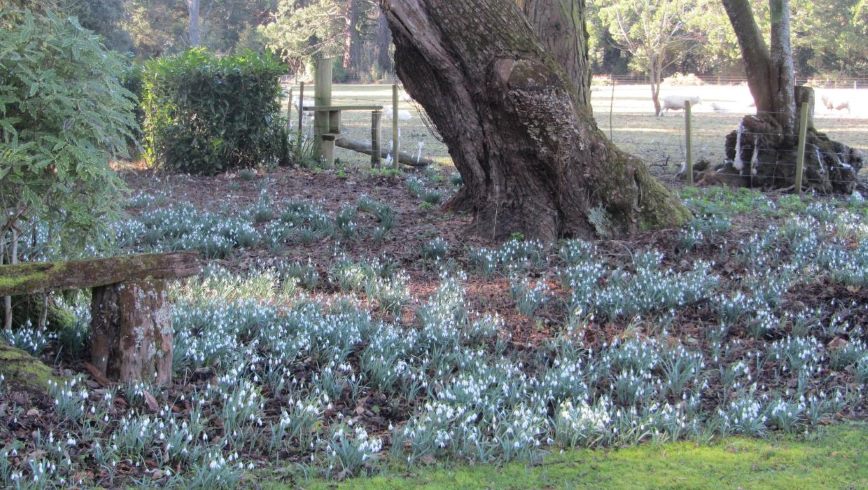NZ Gardener magazine, August 2023
Kate Foster is the fourth generation of her family to live in Terrace Station near the Rakaia River, and she is passionate about preserving the property’s history.
It is no wonder. As visitors progress up the drive, the alpine drama of Mt Hutt gives way to a tunnel of trees formed by towering Sequoiadendron giganteum on one side and Cedrus atlantica on the other.
It’s likely that the sequoia were planted to commemorate Queen Victoria’s Diamond Jubilee in 1897 but the cedars were a much later addition – planted in the 1940s.

Thought to be Thomas Barson, who was a gardener here, circa 1890.
The drive runs past a collection of 19th century farm buildings and then up to the homestead that was built by runholder and eminent politician Sir John Hall and his wife Rose, more than 150 years ago.
Sir John was prime minister of New Zealand from 1879 to 1882, and his support for the Parliamentary Bill which gave women in New Zealand the vote in 1893 made him a household name at that time.
Foster is a great-granddaughter of John and Rose.
“The garden was of such great importance to Sir John that he wrote, ‘it sustains my soul and governs my politics’,” she says. “Whenever he went to Wellington, he would leave detailed instructions for his manager, something like, ‘Dig up and plant out violets which are now too thick.
‘Put a good few under the trees and if there are any to spare, along the walks in the plantation.’ As a result, that 14 hectares of oaks, sycamores, ash and elms is now also home to acres of violets.”
Though it is likely that some trees were planted by previous owners, the Studholmes, in the 1850s, John Hall began developing a garden with a formal Victorian design in 1861.
In recent years, this has evolved into an informal country garden of about one hectare.
Remarkable trees such as horse chestnuts, Judas tree (Cercis siliquastrum), Lawson cypress, gingko, Korean mountain magnolia and celery pine provide structure while much of the wooded area is underplanted with shade-loving perennials and bulbs.
In August, drifts of flowering snowdrops (Galanthus nivalis) delight all who visit.
There weren’t any snowdrops when Foster and her husband Richard first came to live on the 500ha farm in 1971.
That changed a few years later when Kate saw snowdrops growing en masse for the first time.
“Louise Deans at Homebush Station gave me some of hers and they’ve multiplied wonderfully.”
Galanthus nivalis is undoubtedly the mainstay of the snowdrop garden, but Foster also treasures rarer varieties.
‘Flore Pleno’, a double snowdrop, came from Nicky Tripp at Snowdon Station in the Rakaia Gorge; G. ‘Sam Arnot’ was given to her by another good gardening friend.
“I also enjoy two larger varieties: G. elwesii and G. ‘Atkinsii’. Plants that come from friends are what makes my garden special to me, they have stories to tell.”
The patches of snowdrops in the homestead garden impress, but they’re really only a charming introduction to the main spectacle – the large expanses of G. nivalis that are spreading in the nearby woodland.
The look of the garden constantly changes. Snowdrops flower only for a month, but in September there are trilliums, primroses and violets, followed by bluebells.
“Sue Studholme gave me so many bluebells from Coldstream, near Ashburton, that I was able to plant them in drifts. That’s essential in a garden this size. When they flower in October, the woodland is carpeted with blue.”
Foster loves the way snowdrops demand nothing of the gardener.
“They thrive in shade or semi-shade and like lots of leaf litter. My garden soil, river silt with 100 years of leaf mould, is perfect. In these ideal conditions, the snowdrops here at Terrace Station multiply rapidly, each bulb having two or three ‘babies’ each year, meaning that the clumps soon get big.”
Foster says snowdrops are best divided in July, when the shoots first appear through the ground.
“That means there are leaves to hold on to. I suggest that people plant just three or four bulbs, 200mm apart for best effect.”
Foster is particularly pleased with the way one large patch of snowdrops complements an area of pink lily of the valley.
“The lily of the valley doesn’t appear until the snowdrops have finished flowering, meaning that one lot of flowers succeeds the other. That works beautifully.”
Responsibility for maintaining the Heritage New Zealand Category One homestead and garden, and the property’s 19th century farm buildings now rests with the Terrace Station Charitable Trust. During the summer months, Foster works 15-20 hours a week in the garden and is supported by volunteers who host visitors throughout the year.
On Open Garden days in autumn and spring, visitors can bring picnics to enjoy on the spacious lawns, then explore the paths and different garden rooms.
Visitors can view the snowdrops on open days each year. More information: terracestation.org.nz.
First published in NZ Gardener magazine’s August 2023 issue

